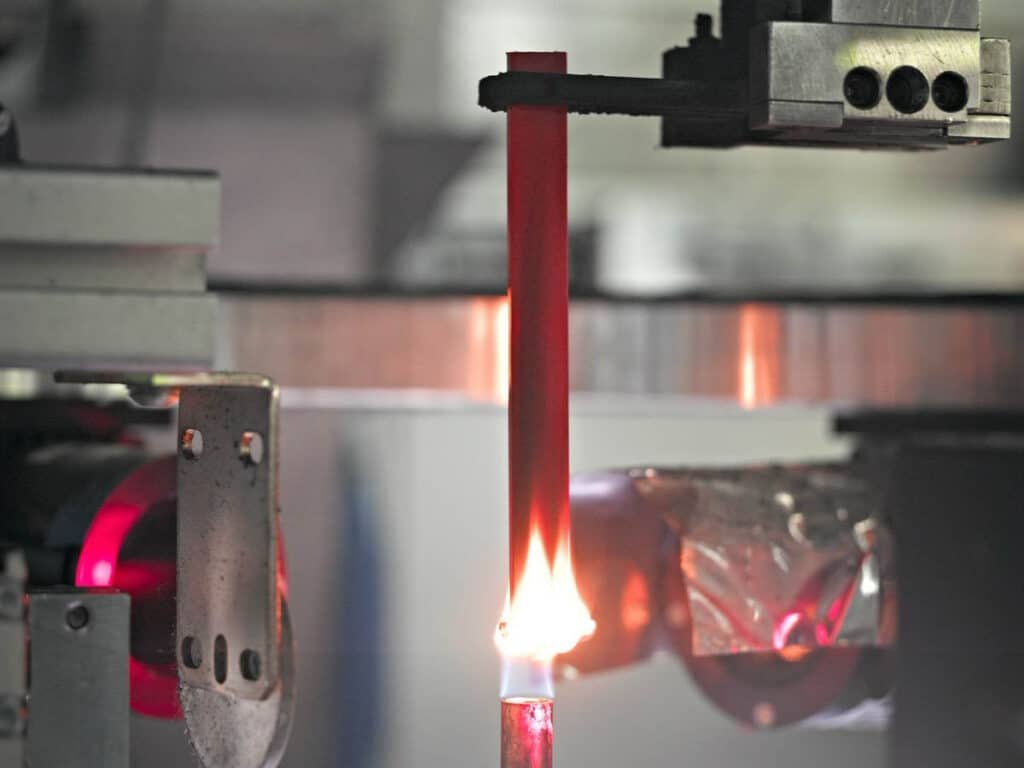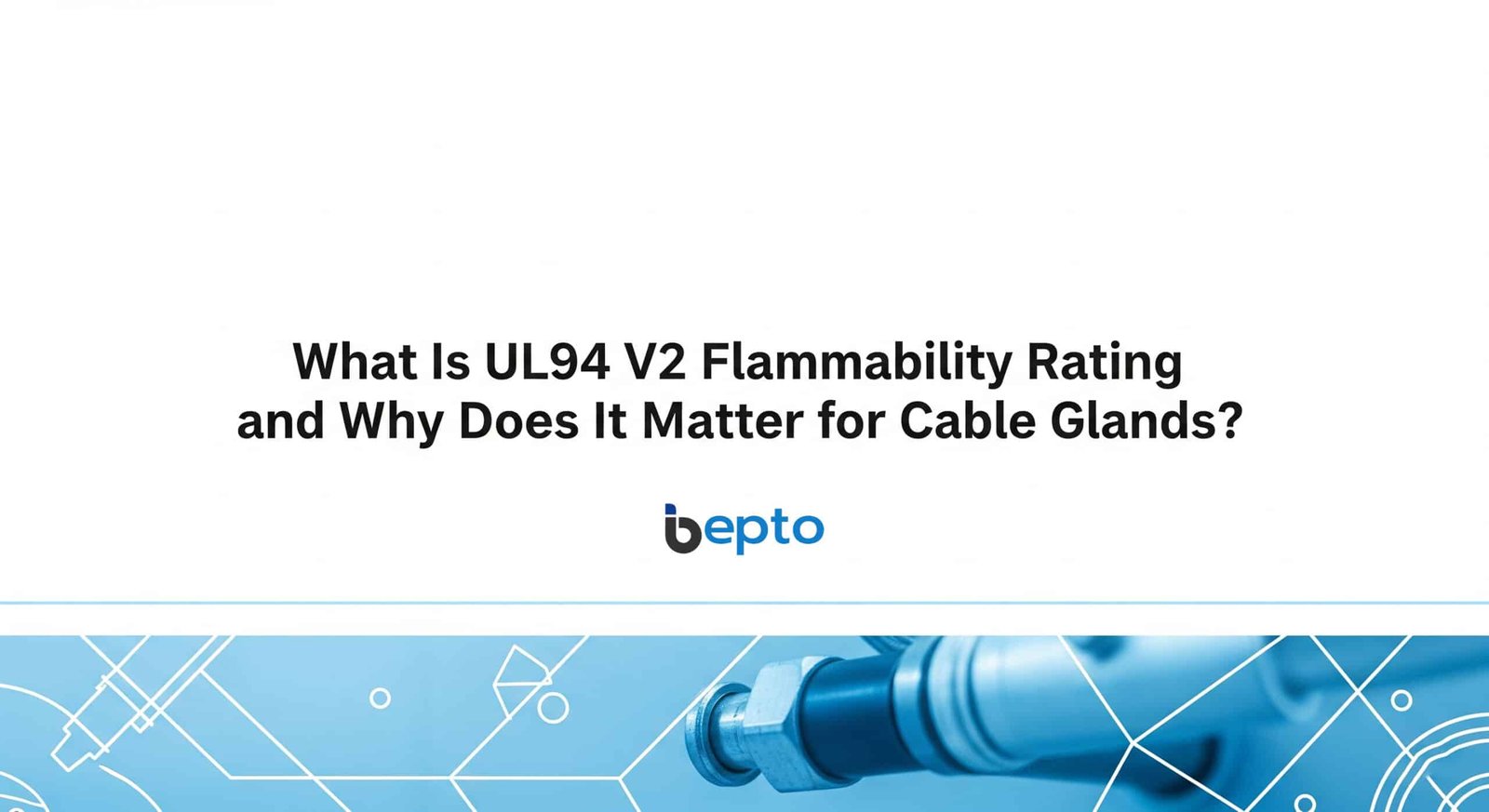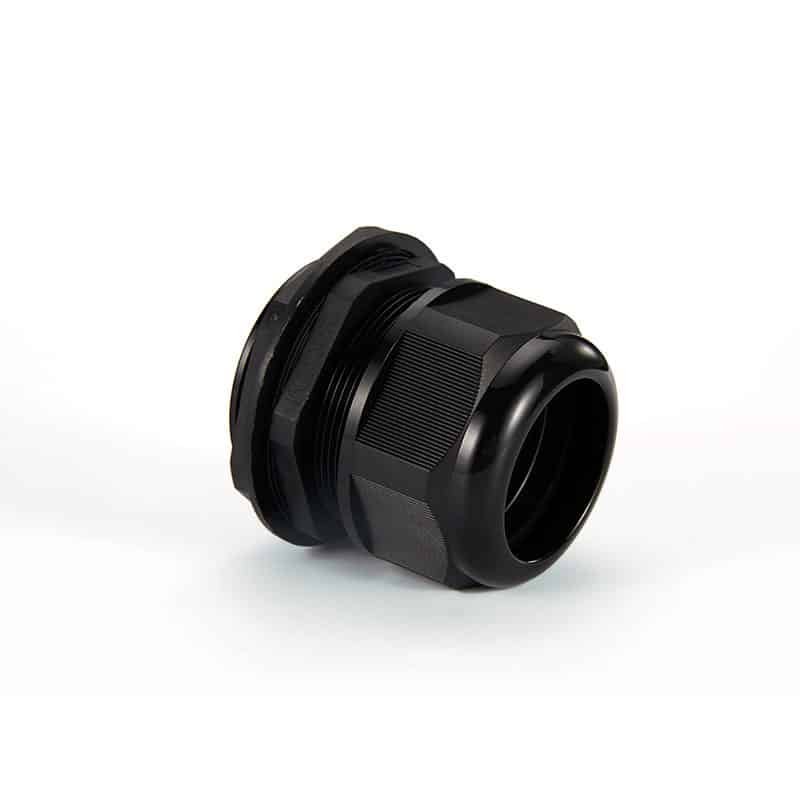When David, a procurement manager from a major automotive manufacturer in Detroit, called me last month, he was frustrated. His previous supplier’s nylon cable glands had failed a critical safety audit because they didn’t meet UL94 V2 standards. The production line was shut down for three days, costing his company over $50,000 in delays.
UL94 V2 is a flammability rating that indicates a material can self-extinguish within 30 seconds after flame removal, with limited flame spread and no flaming drips that ignite cotton. This rating is crucial for cable glands used in automotive, electronics, and industrial applications where fire safety is paramount.
As someone who’s been in the cable gland industry for over a decade, I’ve seen too many companies learn about UL94 ratings the hard way. Understanding these standards isn’t just about compliance – it’s about protecting your equipment, your facility, and most importantly, your people.
Table of Contents
- What Exactly Is UL94 V2 Flammability Rating?
- How Does UL94 V2 Testing Work?
- Why Is UL94 V2 Important for Cable Glands?
- What Materials Typically Achieve UL94 V2 Rating?
- How Does V2 Compare to Other UL94 Ratings?
- FAQs About UL94 V2 Flammability Rating
What Exactly Is UL94 V2 Flammability Rating?
Let me break this down in simple terms that won’t put you to sleep with technical jargon.
UL94 V2 is a specific fire safety classification under the UL94 standard1 that measures how quickly a plastic material stops burning and whether it produces dangerous flaming drips. The “V” stands for “Vertical” because the test specimens are held vertically during testing.

The Key Requirements for UL94 V2
To earn a V2 rating, a material must meet these specific criteria:
- Flame extinction time: After removing the flame source, the material must stop burning within 30 seconds (for each of two flame applications)
- Total burn time: The combined burning time for both flame applications cannot exceed 60 seconds
- Flame spread: No flaming drips2 that ignite cotton placed 12 inches below the specimen
- Afterglow: The material may continue to glow after the flame is extinguished, but this is acceptable for V2 rating
This rating system was developed by Underwriters Laboratories (UL), a global safety certification company that’s been setting safety standards since 1894. When you see UL94 V2 on a cable gland specification sheet, you know that material has been rigorously tested and meets established fire safety benchmarks.
How Does UL94 V2 Testing Work?
Understanding the testing process helps you appreciate why this rating matters so much for your applications.
The UL94 V2 test involves applying a controlled flame to vertically mounted plastic specimens twice, measuring how quickly the material self-extinguishes and checking for dangerous flaming drips.
The Step-by-Step Testing Process
Here’s exactly what happens during UL94 V2 testing:
- Specimen Preparation: Five identical test specimens (typically 5 x 0.5 x 0.125 inches) are conditioned at specific temperature and humidity
- Vertical Mounting: Each specimen is clamped vertically with a piece of surgical cotton placed 12 inches below
- First Flame Application: A standardized Bunsen burner3 flame is applied to the bottom of the specimen for 10 seconds
- Timing Begins: After flame removal, technicians measure how long the specimen continues to burn
- Second Application: After the specimen extinguishes, the flame is reapplied for another 10 seconds
- Final Measurement: The second extinction time is recorded, and any dripping behavior is noted
I remember when Hassan, who runs a chemical processing facility in Dubai, questioned whether this testing was really necessary for his stainless steel cable gland applications. After I explained that even metal glands often use polymer sealing components, he understood why UL94 ratings matter for complete assemblies, not just the main body material.
Critical Success Criteria
For V2 classification, the material must:
- Self-extinguish within 30 seconds after each flame application
- Have a total burn time under 60 seconds for both applications combined
- Not produce flaming particles that ignite the cotton below
- Maintain structural integrity throughout the test
Why Is UL94 V2 Important for Cable Glands?
This is where theory meets real-world application, and trust me, the stakes are higher than you might think.
UL94 V2 rated cable glands provide essential fire safety protection in electrical installations by preventing flame spread along cable pathways and reducing the risk of ignition from electrical faults or external heat sources.
Real-World Fire Safety Applications
Cable glands with UL94 V2 materials are critical in these scenarios:
Automotive Industry: Engine compartments reach extreme temperatures, and electrical faults can occur. V2-rated nylon cable glands ensure that if a fire starts, it won’t spread rapidly through cable entry points.
Industrial Control Panels: Electrical panels house high-current connections that can arc or overheat. Cable glands with proper flammability ratings help contain potential fires within the enclosure.
Building Infrastructure: In commercial buildings, cable glands in electrical rooms and utility spaces must meet fire codes that often reference UL94 standards.
Regulatory Compliance Requirements
Many industries now mandate UL94 ratings:
| Industry | Typical Requirement | Key Applications |
|---|---|---|
| Automotive | UL94 V2 minimum | Engine harnesses, ECU connections |
| Electronics | UL94 V1 or V0 | Consumer devices, industrial controls |
| Building/Construction | UL94 V2 minimum | Electrical panels, HVAC systems |
| Marine | UL94 V2 + additional | Navigation systems, engine rooms |
The consequences of non-compliance aren’t just regulatory – they’re financial and potentially life-threatening. David’s automotive plant shutdown was expensive, but imagine if that fire had spread to adjacent equipment or threatened worker safety.
What Materials Typically Achieve UL94 V2 Rating?
Not all materials are created equal when it comes to fire resistance, and understanding which ones meet V2 standards helps you make informed purchasing decisions.
Common materials that achieve UL94 V2 rating include flame-retardant nylon4 compounds, modified polypropylene, certain polyethylene formulations, and specialized thermoplastic elastomers used in cable gland manufacturing.
Nylon Cable Glands (Most Common V2 Application)
At Bepto, we primarily use flame-retardant PA66 (Nylon 6,6) for our UL94 V2 rated cable glands because:
- Excellent mechanical properties: High tensile strength and impact resistance
- Chemical resistance: Withstands oils, fuels, and most industrial chemicals
- Temperature stability: Maintains properties from -40°C to +100°C
- Cost-effective: Significantly less expensive than metal alternatives
- Easy processing: Allows for complex geometries and integrated sealing features
Material Additives That Enable V2 Rating
The magic happens with flame-retardant additives:
Halogen-based retardants: Traditional but effective, though environmental concerns are driving alternatives
Phosphorus compounds: Increasingly popular for their effectiveness and lower environmental impact
Mineral fillers: Aluminum trihydrate and magnesium hydroxide provide flame retardancy through endothermic decomposition
Synergistic systems: Combinations of different retardants that work together more effectively than individual components
Quality Considerations
Here’s what I tell customers about material quality: not all “UL94 V2” materials are the same. We’ve tested samples from various suppliers, and some barely pass while others exceed requirements significantly. At Bepto, we use materials that not only meet V2 standards but provide safety margins for real-world applications.
How Does V2 Compare to Other UL94 Ratings?
Understanding the UL94 hierarchy helps you choose the right rating for your specific application without over-specifying (and overpaying).
UL94 V2 represents a middle tier in the vertical burning test hierarchy, offering better flame resistance than unrated materials but allowing some flaming drips, unlike the higher V1 and V0 ratings.
Complete UL94 Rating Hierarchy
| Rating | Burn Time After Flame Removal | Flaming Drips | Typical Applications |
|---|---|---|---|
| V0 | ≤10 seconds | Not allowed | Electronics, aerospace |
| V1 | ≤30 seconds | Not allowed | Automotive, appliances |
| V2 | ≤30 seconds | Allowed (non-igniting) | Industrial, construction |
| HB5 | Burns slowly | Allowed | Low-risk applications |
| Unrated | No requirements | No restrictions | Non-critical uses |
When to Choose V2 vs. Higher Ratings
Choose UL94 V2 when:
- Cost is a significant factor
- Application doesn’t require the highest fire safety level
- Flaming drips won’t create additional hazards
- Industry standards specify V2 as acceptable
Consider V1 or V0 when:
- Electronics applications require higher safety
- Flaming drips could ignite other materials below
- Insurance or regulatory requirements demand higher ratings
- Long-term reliability is more important than initial cost
I often tell customers that V2 is like a good safety helmet – it provides solid protection for most situations, while V0 is like a full hazmat suit – necessary for extreme conditions but overkill for everyday use.
Conclusion
UL94 V2 flammability rating isn’t just another technical specification to check off your list – it’s a critical safety feature that can prevent catastrophic failures and protect lives. Whether you’re specifying cable glands for automotive applications, industrial control panels, or building infrastructure, understanding V2 requirements helps you make informed decisions that balance safety, performance, and cost.
Remember David’s expensive lesson: choosing cable glands with proper UL94 V2 certification isn’t just about meeting today’s requirements – it’s about ensuring your installations remain safe and compliant as standards evolve. At Bepto, we’re committed to providing cable glands that not only meet UL94 V2 standards but exceed them with safety margins that give you confidence in your most critical applications.
FAQs About UL94 V2 Flammability Rating
Q: Is UL94 V2 rating mandatory for all cable gland applications?
No, UL94 V2 isn’t universally mandatory, but it’s required in many automotive, electronics, and building applications. Check your specific industry standards and local electrical codes. Many customers choose V2-rated products even when not required because the cost difference is minimal compared to the safety benefits.
Q: How can I verify that a cable gland actually meets UL94 V2 standards?
Look for official UL certification marks on the product and request copies of the actual test reports. At Bepto, we provide complete documentation including UL test certificates for all our V2-rated products. Be wary of suppliers who only claim compliance without providing verification – we’ve seen too many counterfeit certificates in the market.
Q: Do metal cable glands need UL94 ratings since they’re already fire-resistant?
While metal bodies don’t burn, metal cable glands often use polymer sealing elements, gaskets, and thread compounds that do require flame retardancy. Even our stainless steel cable glands at Bepto use UL94 V2 rated sealing components to ensure complete assembly safety.
Q: What’s the cost difference between UL94 V2 and unrated cable glands?
Typically, UL94 V2 rated cable glands cost 5-15% more than unrated versions, depending on size and quantity. However, this small premium is insignificant compared to potential costs of fire damage, production shutdowns, or liability issues. Most of our customers find the peace of mind worth the modest additional investment.
Q: Can UL94 V2 materials withstand high temperatures in automotive applications?
Yes, our UL94 V2 rated nylon cable glands are specifically formulated for automotive temperature ranges, typically -40°C to +125°C continuous operation. The flame retardant additives are selected to maintain effectiveness across this entire temperature range, which is why proper material selection is crucial.
Q: How long does UL94 V2 certification remain valid?
UL94 certifications don’t expire, but they’re tied to specific material formulations and manufacturing processes. If a supplier changes their material composition or production methods, new testing may be required. This is why we maintain detailed material traceability and notify customers of any formulation changes that might affect certifications.
-
Explore the official UL 94 standard, which provides the testing methodology for the flammability of plastic materials. ↩
-
Understand the importance of the flaming drip test and how it is used to assess fire propagation risk in material safety standards. ↩
-
Learn about the Bunsen burner, a common piece of laboratory equipment used to produce a single, open gas flame for heating and sterilization. ↩
-
Discover the science behind flame retardant additives and the mechanisms they use to inhibit or suppress combustion in plastics. ↩
-
Understand the UL94 HB (Horizontal Burning) test and how it differs from the more stringent vertical (V) tests. ↩



